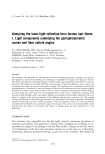j. Cosmet. Sci., 54, 289-300 (May/June 2003) Effect of soaking and natural moisturizing factor on stratum corneum water-handling properties MARTY O. VISSCHER, GAURAV T. TOLIA, R. RANDALL WICKETT, and STEVEN B. HOATH, The Skin Sciences Institute (M. O.V., S.B.H.), Cincinnati Children's Hospital Medical Center (M.O.V., S.B.H.), and College of Pharmacy (G.T.T., R.R.W.), University of Cincinnati, Cincinnati, OH 45267. Accepted for publication June 18, 2002. Presented as a poster at the Annual Scientific Seminar of the Society of Cosmetic Chemists, New Orleans, May 2001. Synopsis Stratum corneum (SC) hydration is partially regulated by water-soluble molecules, natural moisturizing factor (NMF) that is associated with the corneocytes. Routine water exposure, e.g., bathing, may deplete NMF and alter the SC water-handling properties. We determined the effects of bathing and solvent extraction on the volar forearm skin of eleven healthy volunteers. Acetone/ether (A/E) was used to remove surface and upper SC lipids. Adjacent sites were soaked for ten minutes or treated with the A/E-plus-soak combination. Subsequently, an NMF formulation was applied to the treated sites, and transepidermal water loss (TEWL), hydration, and moisture accumulation rate (MAT) were measured. A/E extraction increased TEWL, but did not effect MAT. Soaking produced a short-term increase in TEWL, followed by a decrease, and substantially reduced MAT, an effect that was maintained for five hours. NMF application significantly decreased TEWL and significantly increased MAT for all sites. The replacement experiment suggests that the MAT reduction occurred as a result of extraction of hygroscopic NMF components. The effects of soaking and NMF application are more readily detected by the MAT technique, whereas TEWL is more sensitive to A/E extraction. The results support the use of multiple assessments of barrier function and raise questions about the effects of cumulative repeated water exposure on SC function. INTRODUCTION The stratum corneum (SC) forms a dynamic interface between the environment and the internal milieu. Proper hydration of the SC is essential to provide an effective barrier to water loss and for optimum skin function (1). Plasticization of the SC imparts flexibility and prevents cracking, fissuring, barrier damage, and loss of integrity. SC moisturization occurs as a result of the inherent barrier to water loss provided by the corneocytes embedded in the lipid bilayer matrix and by the inherent humectancy of specific cellular components (2). Hydration is necessary for proper desquamation of the outer SC by facilitating degradation of desmosomal attachments (3). Topical moisturizers, used to treat dry, scaly skin conditions, provide humectancy and water-holding capability with 289
290 JOURNAL OF COSMETIC SCIENCE ingredients such as glycerin. Certain moisturizers impart a physical barrier to water loss with components such as petrolatum (4,5). In contrast to the desirable effects of hydration, prolonged exposure of the SC to high levels of water causes maceration, barrier breakdown, and dermatoses, including inflam- mation, irritation, and urticaria (6-11). Warner et al. (12) described damage to the SC following prolonged exposure to water. Abnormalities included disruption of intercel- lular lamellar lipid bilayers, degradation of corneodesmosomes, and formation of amor- phous regions within the intercellular lipid. Repetitive exposure of the skin to water during routine bathing and hand washing is a common practice for many individuals. Imokawa et al. (13) and Jukura et al. (14) reported the extraction of soluble amino acids following i, vitro exposure of isolated human stratum corneum to a 30-minute water soak or to an acetone/ether extraction (30 min) followed by a water soak (30 min). The extracted amino acids were constituents of natural moisturizing factor (NMF), the compounds that confer water-holding properties to the SC (15). Ramsing and Agner (16) described the effects of water soaking on irritated human skin in which subjects were exposed to water twice daily for 15 minutes over two weeks. A significant increase in blood flow was observed, but barrier function (TEWL) and baseline hydration were not significantly impacted. Limited i, vivo information has been reported about the effects of routine water exposure during bathing or showering on the water-handling properties of the SC, i.e., barrier function, hydration, and water-holding capacity. Since NMF consists of water-soluble materials, routine bathing might be expected to alter the NMF content of the stratum corneum. We hypothesized that short-term exposure to water i, vivo removes NMF and alters the SC water-handling properties during the immediate post-bath period. In this study, we report the i, vivo effects on SC water interactions of brief skin exposure to a water soak followed by the topical application of an NMF formulation. We discuss the implications of the results for current skin care practices. MATERIALS AND METHODS SUUJF•CTS Eleven healthy adult female subjects, aged 22-53 years (mean 30 years), were enrolled during June of 2000. Exclusion criteria included visually dry forearm skin and/or low rates of moisture accumulation under probe occlusion (0.28 capacitive reactance units/ sec), dermatological conditions (psoriasis, eczema, irritant dermatitis, etc.), or steroid or insulin therapy. The Institutional Review Board of the University of Cincinnati Medical Center approved the protocol. All subjects provided informed consent prior to their inclusion in the study. BIOPHYSICAL INSTRUMENTATION Transepidermal water loss (TEWL) was determined using a DermaLab evaporimeter (Cortex Technology, Denmark). Baseline hydration and rate of moisture accumulation (MAT) were measured with a NOVA © Dermal Phase Meter (NOVA © Technology, Portsmouth, NH). The MAT uses changes in skin capacitive reactance (the ratio of
Purchased for the exclusive use of nofirst nolast (unknown) From: SCC Media Library & Resource Center (library.scconline.org)


























































































